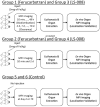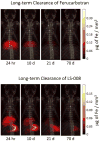Tracking short-term biodistribution and long-term clearance of SPIO tracers in magnetic particle imaging
- PMID: 28177301
- PMCID: PMC5739049
- DOI: 10.1088/1361-6560/aa5f48
Tracking short-term biodistribution and long-term clearance of SPIO tracers in magnetic particle imaging
Abstract
Magnetic particle imaging (MPI) is an emerging tracer-based medical imaging modality that images non-radioactive, kidney-safe superparamagnetic iron oxide (SPIO) tracers. MPI offers quantitative, high-contrast and high-SNR images, so MPI has exceptional promise for applications such as cell tracking, angiography, brain perfusion, cancer detection, traumatic brain injury and pulmonary imaging. In assessing MPI's utility for applications mentioned above, it is important to be able to assess tracer short-term biodistribution as well as long-term clearance from the body. Here, we describe the biodistribution and clearance for two commonly used tracers in MPI: Ferucarbotran (Meito Sangyo Co., Japan) and LS-oo8 (LodeSpin Labs, Seattle, WA). We successfully demonstrate that 3D MPI is able to quantitatively assess short-term biodistribution, as well as long-term tracking and clearance of these tracers in vivo.
Figures









References
-
- Abdollah Maha R, et al. Prolonging the circulatory retention of SPIONs using dextran sulfate: in vivo tracking achieved by functionalisation with near-infrared dyes. Faraday discussions. 2014;00:1–18. doi: 10.1039/c4fd00114a. url: http://www.ncbi.nlm.nih.gov/pubmed/25298115. - DOI - PubMed
-
- Ahrens Eric, Bulte Jeff. Tracking immune cells in vivo using magnetic resonance imaging. Nature reviews Immunology. 2013;13(10):755–63. doi: 10.1038/nri3531. url: http://dx.doi.org/10.1038/nri3531. - DOI - DOI - PMC - PubMed
-
- Allen Theresa M, Cullis Pieter R. Liposomal drug delivery systems: From concept to clinical applications. Advanced Drug Delivery Reviews. 2013;65(1):36–48. doi: 10.1016/j.addr.2012.09.037. url: http://dx.doi.org/10.1016/j.addr.2012.09.037. - DOI - DOI - PubMed
-
- Antonelli Antonella, Sfara Carla, Battistelli Serafina, Canonico Barbara, Arcangeletti Marcella, Manuali Elisabetta, Salamida Sonia, Papa Stefano, Magnani Mauro. New Strategies to Prolong the In Vivo Life Span of Iron-Based Contrast Agents for MRI. Louie Angelique., editor. PLoS ONE. 2013;8(10):e78542. doi: 10.1371/journal.pone.0078542. url: http://dx.plos.org/10.1371/journal.pone.0078542. - DOI - DOI - PMC - PubMed
-
- Antonelli Antonella, Sfara Carla, Weber Oliver, Pison Ulrich, Manuali Elisabetta, Salamida Sonia, Magnani Mauro. Characterization of ferucarbotran-loaded RBCs as long circulating magnetic contrast agents. Nanomedicine. 2016;11 doi: 10.2217/nnm-2016-0216. nnm–2016–0216. url: http://www.futuremedicine.com/doi/10.2217/nnm-2016-0216. - DOI - DOI - PubMed
MeSH terms
Substances
Grants and funding
LinkOut - more resources
Full Text Sources
Other Literature Sources
Medical
